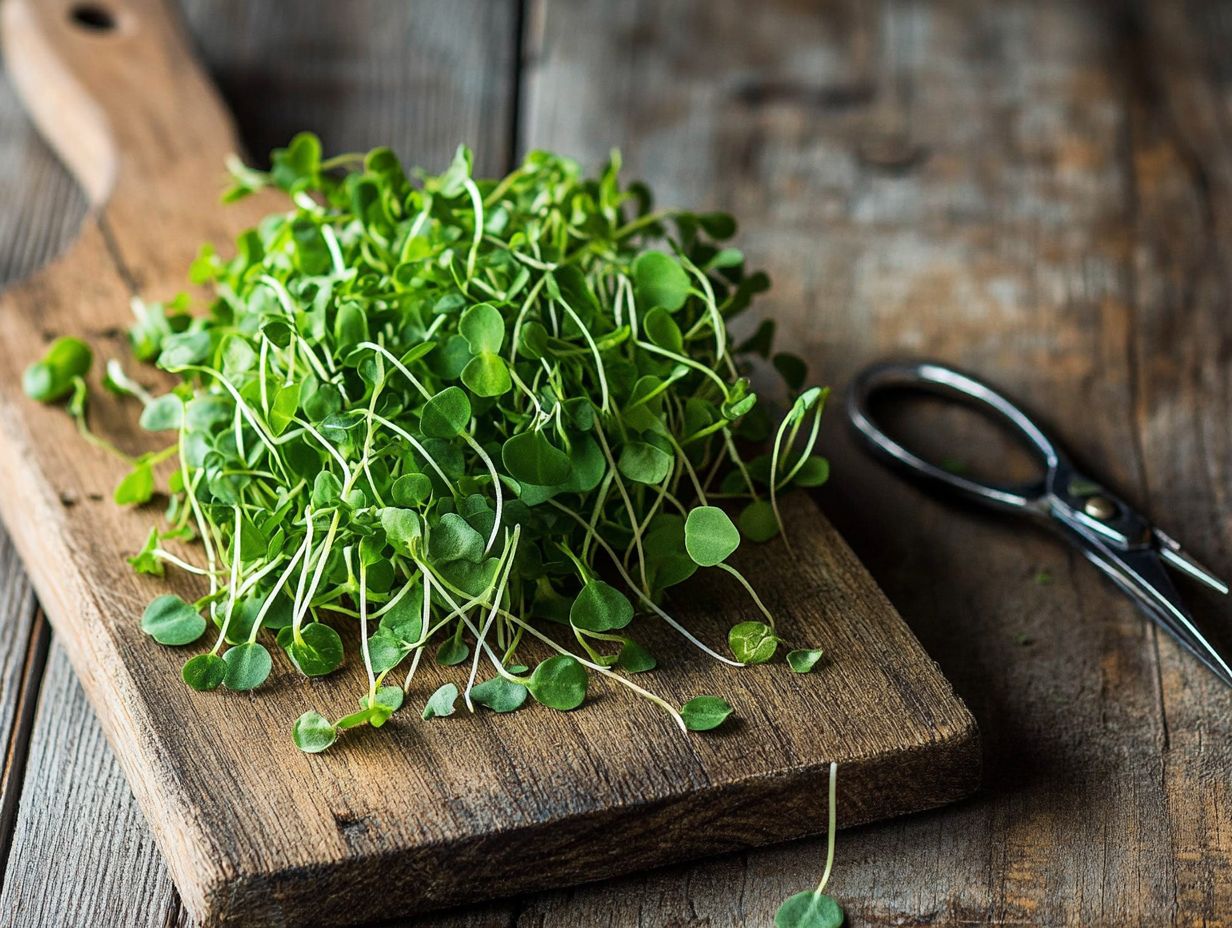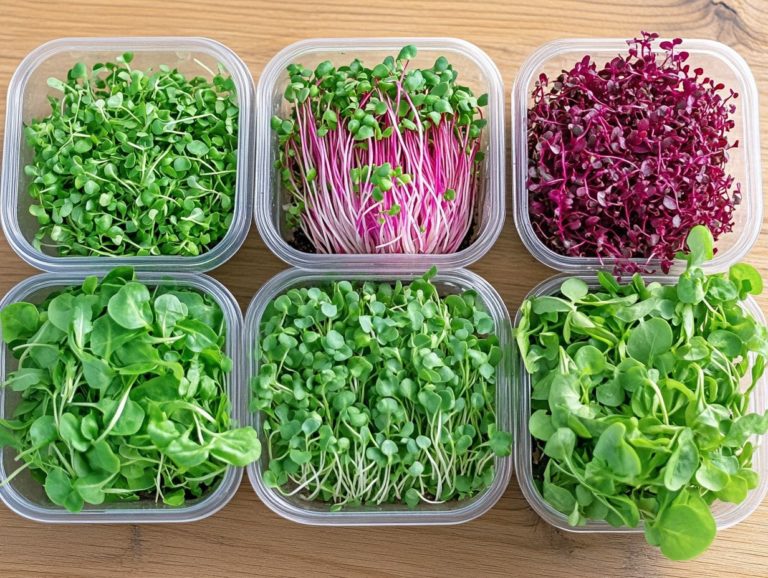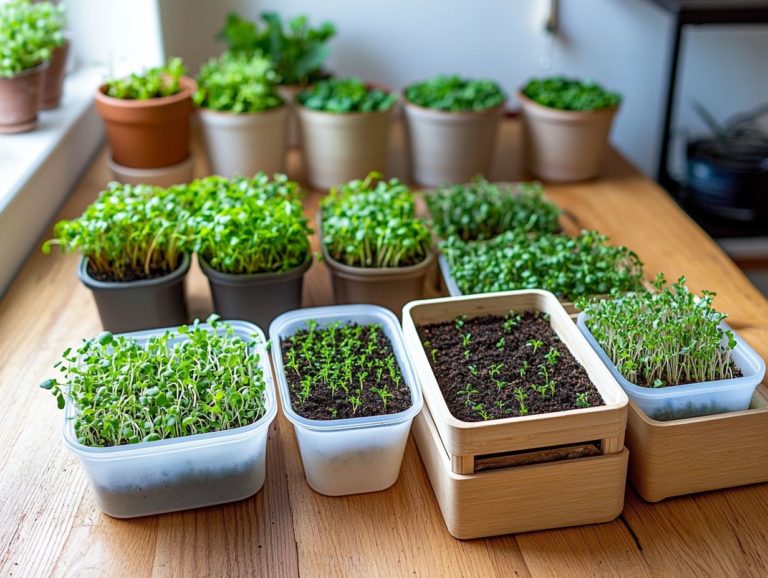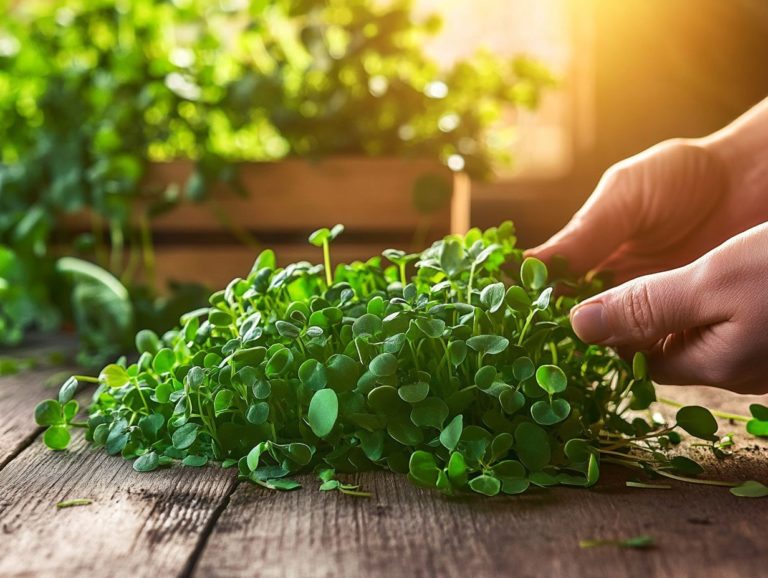5 Tips for Quick Microgreen Harvests
Microgreens have emerged as a sensation in the culinary landscape, celebrated not only for their vibrant flavors but also for their striking aesthetics and remarkable nutritional advantages.
If you re eager to cultivate your own, this article presents five essential tips to ensure swift and abundant microgreen harvests. From selecting the perfect varieties to optimizing your growing conditions, you ll discover everything you need to succeed.
You will explore the myriad benefits of homegrown microgreens and learn how to seamlessly incorporate them into your meals. Get ready to take your gardening skills to the next level and enhance the flavors of your culinary creations!
Contents
Key Takeaways:

- Choose fast-growing varieties for a quick harvest.
- Use quality soil and natural fertilizers for better growth.
- Maintain the right temperature and lighting for optimal results.
1. Choose Fast-Growing Varieties
Selecting fast-growing microgreens is essential for a fruitful gardening experience. These nutrient-packed plants offer quick yields and numerous health benefits.
Varieties like Arugula, Broccoli, and Cabbage are not just easy to grow; they re also packed with essential nutrients like potassium, iron, and zinc, helping you grow better and eat healthier.
Consider adding Radish and Pea varieties to your garden. They sprout rapidly, often within a week, and their vibrant flavors can truly elevate your culinary creations. For those interested in growing microgreens, a step-by-step guide to sowing microgreens can provide valuable insights. The growth cycle of microgreens is typically short, making them ideal even for the most impatient of gardeners.
Employing simple techniques, such as soaking seeds beforehand using a seed presoak method, can enhance germination rates. Additionally, using planting trays helps maintain an organized and efficient growing environment.
Selecting quality seeds is crucial as it directly impacts both the speed of growth and the overall health benefits you ll reap, ensuring you enjoy the best possible flavor and nutrition from your small-scale garden.
2. Use High-Quality Soil and Fertilizer
Quality soil and fertilizer are key to growing healthy microgreens. They enhance growth rates and nutrient levels, ensuring you enjoy the best produce.
Using high-quality soil and fertilizer is essential when growing microgreens, as it directly influences their growth rate, nutrient absorption, and overall health benefits, resulting in more nutrient-dense produce. A good growing medium, such as coconut coir or peat-based mixes, provides the necessary support for these delicate plants while ensuring they receive the vital nutrients they need to thrive.
When selecting a growing medium, focus on blends that retain moisture without becoming waterlogged; excessive moisture can lead to root rot, which is a nightmare for any cultivator. Organic fertilizers, like seaweed extract or compost, enhance nutrient levels without introducing harmful chemicals that could disrupt the microgreens’ delicate nature.
Regularly monitoring soil moisture is crucial since microgreens need a consistent level of humidity to germinate and grow optimally. By preparing the growing medium properly and choosing suitable organic fertilizers, you can significantly boost the vitality and nutritional profile of your microgreens. Additionally, learning techniques for growing microgreens year-round can help ensure a successful harvest throughout the seasons.
3. Optimize Temperature and Lighting
Setting the right temperature and lighting is crucial for vibrant microgreens. Aim for a temperature between 60 and 75 degrees Fahrenheit for best growth.
For various types of microgreens, the ideal temperature typically hovers between 60 to 75 degrees Fahrenheit. You can easily manage fluctuations by using monitoring devices like thermometers or smart sensors to keep a close eye on conditions.
Incorporating efficient lighting systems think LED or fluorescent options not only boosts growth rates but also provides the necessary spectrum for photosynthesis. Position these lights about 6 to 12 inches above your plants for optimal absorption.
If you re lucky enough to have south-facing windows, harnessing that natural sunlight can significantly benefit your plants. Just remember that as seasons change, you may need to adjust your pots or use reflective materials to maximize light exposure.
The Perfect Time to Harvest Your Microgreens!

Harvesting microgreens at the right time is a game-changer for freshness! It maximizes their health benefits and flavor, ensuring they stay nutrient-dense for your culinary creations. Key indicators like the first real leaves and soil moisture levels are crucial in determining the ideal moment to cut your microgreens.
These delicate greens are ready when they showcase their first set of true leaves, which can vary based on the variety you’re growing. Monitoring leaf development is essential, and checking soil moisture is vital too. Overwatered plants can become weak and susceptible to diseases, while those that are underwatered may wilt before you’ve had a chance to harvest. Additionally, understanding how to rotate crops for microgreens can help maintain plant health and yield.
Grab your sharp, sanitized scissors or knife to cut your microgreens effectively. Make clean cuts just above the soil line while being careful not to disturb the roots. This technique allows any remaining plants to continue growing, helping maintain the overall health of the greens you have left. Avoid the top mistakes in growing microgreens to ensure your success.
Store and Clean Your Microgreens for Maximum Freshness!
Storing and cleaning your microgreens is vital for preserving their freshness, flavor, and health benefits. Effective cleaning techniques not only rid them of contaminants but also extend their shelf life, meaning you can enjoy those delightful greens for even longer!
To kick off the cleaning process, gently rinse the microgreens under cool, running water; just be careful not to bruise them. A colander works wonders here, allowing you to rinse thoroughly while preventing any stubborn soil from sticking around. For those interested in maximizing their harvest, check out this guide on how to extend the growing season for microgreens.
Once cleaned, pat them dry with a clean paper towel or use a salad spinner to remove any excess moisture. For the best storage, these delicate greens should find their home in airtight containers in the refrigerator, protecting them from air exposure and moisture that could compromise their quality.
Don’t wait to enjoy the full flavor and benefits of your microgreens! Regularly inspect them for any signs of sliminess or discoloration. Freshness is essential for ensuring your microgreens retain their peak nutritional value and vibrant flavor. To enhance your growing experience, consider learning how to maximize yields from microgreens!
What Are Microgreens and Why Are They So Popular?
Microgreens are young, edible plants you harvest just after their first real leaves emerge. They add a delightful burst of flavor and color to your dishes while offering impressive health benefits, thanks to their high concentration of vitamins and minerals. These nutrient-dense additions can elevate any meal!
Varieties like Arugula, Broccoli, and Cilantro have skyrocketed in popularity among home gardeners, and it s easy to see why they’re simple to grow, versatile in the kitchen, and perfectly align with the Dietary Guidelines for Americans, which encourage an increased intake of vegetables.
Unlike regular vegetables, microgreens are harvested at a much younger stage. This early pick allows them to pack a more intense flavor and streamlined nutritional profile. Their rise in popularity is linked to the recent trend of home gardening, embraced by many in search of fresh, organic ingredients and successful microgreen germination tips for their culinary creations.
Innovative culinary methods have put these tiny greens in the spotlight, showcasing their versatility as garnishes, key ingredients in salads, or vibrant additions to sandwiches and wraps. Notably, certain varieties like Radish and Beet microgreens are celebrated for their unique flavors and potential anti-inflammatory properties, solidifying their place in the health-conscious kitchen.
What Are the Benefits of Growing Your Own Microgreens?
Growing your own microgreens provides a wealth of health benefits, including access to fresh vegetables full of nutrients that can elevate your daily diet. For health-conscious individuals, home gardening is a rewarding endeavor. Beyond nutrition, growing microgreens offers economic benefits, reduces food waste, and provides a fulfilling hobby that reconnects you with your food source.
These tiny greens are packed with vitamins A, C, E, and K, as well as essential minerals like iron and calcium, making them perfect for enhancing your overall health. Expert Francesco Di Gioia notes that even a small addition of microgreens to your meals can significantly boost your nutrient intake. The best part? You don t need a big garden or expensive equipment; a simple windowsill or balcony will do.
This helps you save money on grocery bills and promotes sustainable practices by reducing reliance on store-bought produce, which often comes wrapped in plastic. Many enthusiasts enjoy the entire process, sharing stories of personal growth and relishing the satisfaction of nurturing their own food.
What Are Some Common Mistakes to Avoid When Growing Microgreens?

Many new growers stumble into common pitfalls when trying to cultivate microgreens. Overwatering, neglecting soil moisture, and selecting the wrong varieties can hinder your gardening success and reduce the nutritional benefits of your crops. By recognizing these mistakes, you can significantly improve your yields and cultivate a healthier home garden.
To overcome these challenges, establish a consistent watering routine that keeps the soil moist but not soggy, promoting robust growth. The right amount of light is also crucial; it directly influences the vibrancy and flavor of your greens. Some varieties thrive in direct sunlight, while others prefer indirect light. For example, one successful grower of sunflower microgreens found that using a grow light dramatically improved his crop quality. If you’re interested in maximizing your gardening potential, check out this guide on how to grow microgreens in a small space.
Implementing proper harvesting techniques is essential for growing back after harvesting and minimizing waste, ensuring you have a steady supply of fresh greens. By learning from seasoned growers, you can cultivate flourishing microgreens by following essential tips for growing microgreens at home, enjoying both delicious flavors and enhanced nutrition.
How Can One Incorporate Microgreens into Their Diet?
Incorporating microgreens into your diet can transform your home cooking, infusing vibrant flavors and essential nutrients into your dishes while amplifying their health benefits. Whether you sprinkle them on salads, blend them into smoothies, or use them as garnishes, microgreens offer a world of culinary creativity.
These petite powerhouses don t just deliver exceptional taste; they also provide a rich source of vitamins, minerals, and antioxidants. Imagine adding peppery arugula microgreens to a classic caprese salad for a delightful zing, or enhancing your pasta dishes with the mild, sweet flavor of basil microgreens. Integrating colorful beet microgreens into your morning omelet or smoothie not only elevates visual appeal but also adds an extra nutritional punch.
With their remarkable diversity, microgreens can seamlessly blend into various meals, allowing you to savor exquisite flavors without compromising nutrition. Don t miss out on the delicious flavors and health benefits you could be enjoying today!
Start growing your own microgreens today and discover the joy of incorporating them into your meals!
What Are Some Creative Ways to Use Microgreens in Cooking?
Microgreens can elevate your home cooking in truly innovative and creative ways. They transform simple dishes into gourmet experiences. With their vibrant colors and textures, microgreens enhance both flavor and presentation, offering a feast for the eyes as well as the palate. Not only do these tender seedlings deliver a nutritional boost, but they also serve as a visually striking garnish that elevates any meal.
Imagine the delightful burst of flavor they provide making them the perfect addition to a wide array of cuisines. For appetizers, top your bruschetta with a mix of microgreens for a refreshing twist. In entrees, incorporate them into salads, stir-fries, or even use them as a finishing touch on grilled meats and seafood, instantly bringing brightness to your plate.
But don t stop there! You can blend microgreens into smoothies or use them as a garnish in cocktails, adding a unique and stylish flair to your beverages. Their versatility allows you to experiment and showcase these little greens in countless ways, breathing new life into your culinary creations.
Are There Any Safety Concerns When Growing and Consuming Microgreens?
Microgreens are generally safe, but pay attention to cleanliness. Properly clean your tools and wash your greens to avoid harmful germs. Potential contamination and the necessity for proper cleaning techniques play a crucial role in ensuring your food safety. By understanding these risks, you can fully appreciate the health benefits of microgreens without compromising your well-being.
To ease any worries, adopt rigorous sanitation procedures. Sterilize your containers and tools before planting, and make it a habit to wash your microgreens thoroughly before consumption to eliminate any lingering bacteria. It’s also important to source your seeds from reputable suppliers, as low-quality seeds can harbor harmful germs. For optimal results, consider timing your microgreens correctly, ensuring you harvest at the right moment.
By being mindful of these practices, you can dive into the vibrant flavors and nutritional perks of microgreens while minimizing the risk of foodborne illnesses.
Frequently Asked Questions

Curious about microgreens?
They’re tiny edible greens packed with flavor and nutrients! Microgreens are popular for their intense flavor, variety of nutrients, and ease of growing in small spaces.
Why is it important to harvest microgreens quickly?
The flavor and freshness of microgreens can deteriorate quickly. It s important to harvest them as soon as they reach the desired size to enjoy their full taste and nutritional benefits.
What are 5 tips for quick microgreen harvests?
1. Use sharp scissors or a clean knife to cut the microgreens just above the soil line, being careful not to pull or tug on the delicate stems.
2. Harvest in the morning when the plants are hydrated and less stressed from heat or light.
3. Keep the harvested microgreens in a cool, dark place until ready to use.
4. Avoid overcrowding the growing tray to allow for better air circulation and faster growth.
5. Use a well-draining potting mix and water from the bottom to prevent excess moisture and promote quicker growth.
Can microgreens be harvested multiple times?
Yes! Some microgreens such as arugula, cilantro, and radish can be harvested multiple times. Simply cut the greens above the soil line and wait for them to regrow before harvesting again. However, some varieties only have one harvest, so it is important to research the specific type of microgreens you are growing.
How long do microgreens take to grow before they can be harvested?
Microgreens typically take between 7-14 days to grow before they can be harvested. However, the growth rate can vary depending on the type of microgreen and growing conditions.
Are there any special storage tips for harvested microgreens?
To prolong the freshness of harvested microgreens, store them in a sealed container or plastic bag with a damp paper towel. They can be kept in the refrigerator for 3-5 days, but it s best to use them as soon as possible for optimal flavor and nutrition.
Start experimenting with microgreens in your kitchen today!






